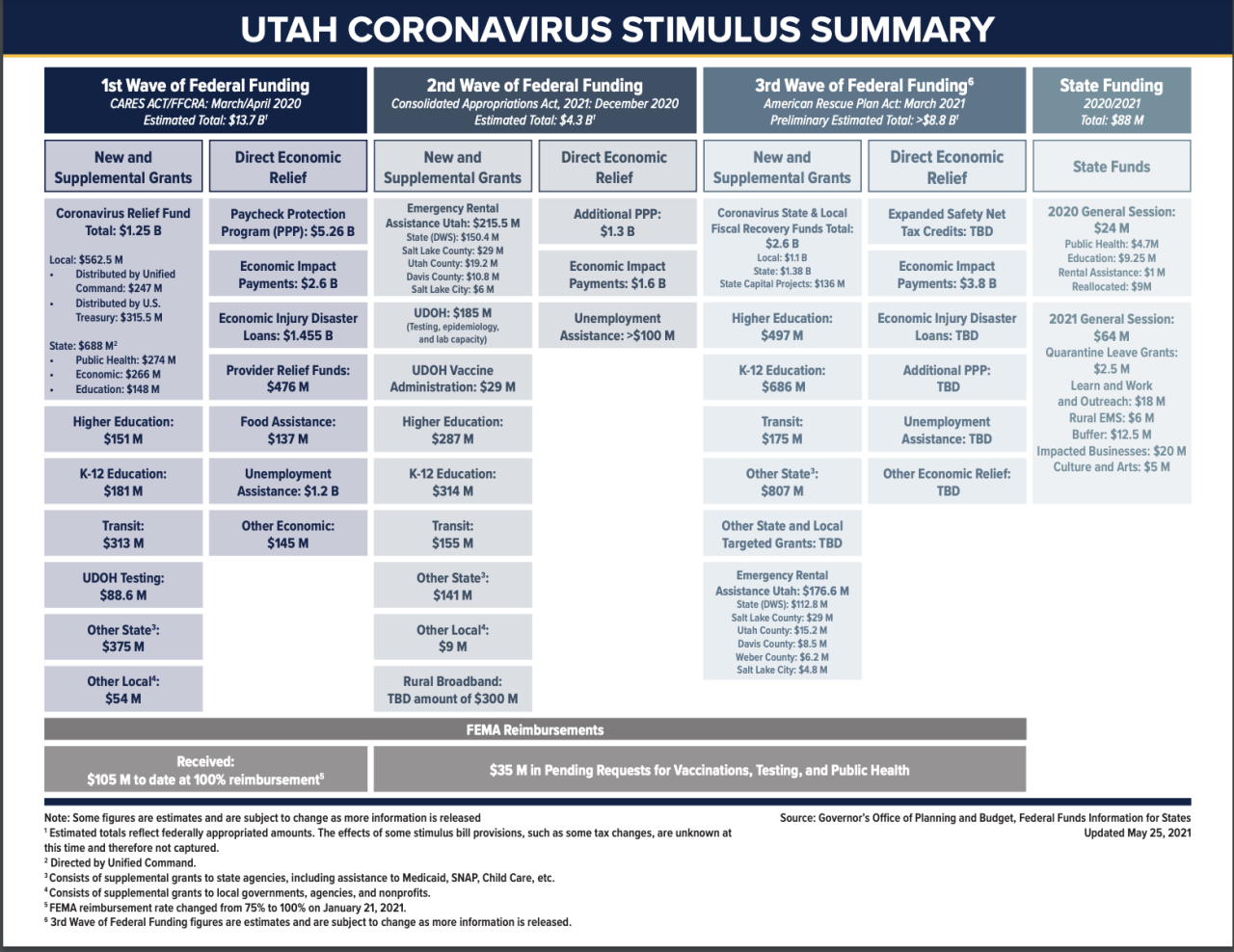SALT LAKE CITY — A once-in-a-lifetime event like the COVID-19 pandemic isn't cheap.
Financial reports reviewed by FOX 13 show the extent of state spending to respond to the pandemic, as well as what has been calculated in terms of economic impact to taxpayers.
"To put a price tag on a pandemic? A global pandemic? It’s money well spent for what we had to do," said Utah Department of Public Safety Commissioner Jess Anderson, who headed up the state's COVID-19 Unified Command. "I couldn’t be more proud of where Utah is in the response to all of this."
Of course, the money does not factor in the cost of human life (which you can't put a price tag on). As of Friday, 2,297 Utahns have died due to COVID-19 according to the Utah Department of Health.
Spending logs show millions for COVID testing, vaccine rollout, personal protective equipment, business loans and grants, education spending boosts and other line-item needs. The state is reimbursed by money from the federal CARES Act and the American Rescue Plan Act.
"The locals got direct money and schools got direct money, as you know," said Sophia DiCaro, the executive director of the Governor's Office of Planning & Budget. "PPP, businesses got some money."
But when you add it all up?
"About $26 billion," DiCaro said in an interview with FOX 13. "To give you a sense of the scale for that, over the last three tranches, that’s about the same size of our entire state budget."
The money was earmarked to either respond to or recover from the COVID-19 pandemic. Not all of it went to the state. Some of it went directly to local governments, educational institutions and consumers in the form of grants and loans.

Anderson, who now is on a committee overseeing pandemic-related spending, said the state has around 196 different contracts with entities for pandemic response. It has included everything from turning the Salt Palace into a warehouse for personal protective equipment, to renting care centers to act as isolation sites for people who are positive for the deadly virus. The state also leased the Mountain American Expo Center when it was feared the facility would be needed for a field hospital when cases surged.
Breaking down the spending, figures presented to the Utah State Legislature's powerful Executive Appropriations Committee show a lot of purchases for COVID-19 testing and vaccination efforts. But there are also some other things thrown in. For example:
- $38 million allocated for housing assistance
- $30 million for broadband internet expansion across the state
- $3.9 million just to boost WiFi in remote San Juan County schools
- $5 million went to bolster Utah's mining industry
- $100,000 for winter tourism and Utah's ski industry
- $485,000 for mink farms which have dealt with COVID outbreaks
Lately, more money has been spent on vaccine clinics.
"The quicker you get people vaccinated, the quicker you’re going to recover," DiCaro said.
Utah has weathered the pandemic much better than other states, emerging with a low unemployment rate and a strong economy. So far, DiCaro said, the state has spent about 96% of CARES Act money given to it. The legislature intends to use ARPA funding for more forward-looking projects.
"Grants for small businesses, for cultural communities, for example. Those were hardest hit," she said.
But with Utah doing so well coming out of the pandemic, there are concerns in the governor's office and Republican legislative leadership about "overheating" the economy.
"We do believe this is an artificial injection into our economy," DiCaro said of federal relief money. "It could potentially artificially inflate things, make things look better, which could lead to budget, structural issues in the future."
That's why it is unlikely to see money be used for tax cuts beyond what the legislature has already given out this year (lawmakers cut the Social Security and military retirement taxes and restored the dependent exemption).
The legislature this year also passed a bill that put a cap on emergency spending by the governor. FOX 13 first reported last year on then-Governor Gary Herbert's use of "emergency procurement powers," spending over $100 million on COVID-related needs and bypassing a traditional public bid process. It led to criticism of some of the purchases, particularly lucrative tech contracts.
Anderson said the criticism was fair — but justified it as an emergency.
"It’s so important to have that ability to do that... to do emergency contracts outside of the procurement process. However, there’s also a day of reckoning," he said.
The government's use of COVID-19 relief money will also be scrutinized by Utah State Auditor John Dougall.
"We always recommend that folks that get federal money understand what the rules are and they comply with that. COVID relief monies, some folks seem to believe there aren’t rules," he said, adding that it is not uncommon to have auditors review federal spending that went to the state, local governments and educational institutions.
While $26 billion — and counting — is a lot of taxpayer money, Anderson told FOX 13 it is still below what it is projected to cost the state for a major earthquake (larger than the 5.7 quake the Wasatch Front experienced in the early days of the pandemic).
"We project $30 billion alone for that and every year that goes up for inflation and the costs for doing business. That’s for a major earthquake," he said.
See some of the line-item COVID-spending here:


